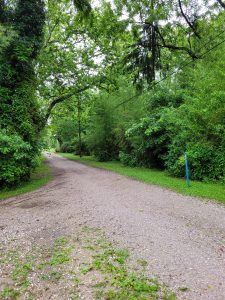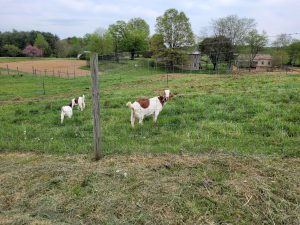The Power of Humanity on the World
Arman Khoobehi
The Students of HUM2020
My name is Arman Khoobehi. For my PhotoVoice project, I asked my friend Persephone Nonorry to take several pictures of the area she lives in for me. She is 23 years old and lives in a rural area of West Virginia. I asked for her help because I thought the rural environment would give an interesting perspective on the impact humans can have in an area that doesn’t have the same level of development as a full city or town.

“The lonely tree reflects a lot of things about how we use and function with the world around us. The tree is clearly not native to the area, that specific tree wasn’t cut like the others on those rolling hills just out of reach. Simply for the reason of being out of place, it’s interesting that often something being out of place can be considered good or bad, but seldom is there a concrete classification. Very frequently that falls onto preconceived notions, such as being considered beautiful or in an extreme case a pest. While it is a simple thing to observe with a tree, it’s simply a pervasive thing that dominates the heuristic-driven actions of a lot of humans. It shows there’s a very thin line between was we value, and what we use and destroy. Never is our abuse of the environment around us one driven of necessity or empathy, but that of being seen as a resource and at times traditional beauty.”
The image shows a very unique tree in the distance standing out amongst other trees. The tree’s odd, forked shape makes it clear from appearance alone that it does not belong in this area, especially because of its placement. It towers above the other trees and stands right against the blue sky, making its uniqueness even more clear. The fact that there’s so much forest shows this is a rural area, making it odder that someone decided to go out of their way to plant a foreign tree here. However, there’s also a house visible in the foreground, showing that people do live in this area. Perhaps it was planet by someone who lives there because they liked how it looked, or there could be a bigger purpose to it being there. This tree shows the effects of humans on the world around them; this tree now stands somewhere it shouldn’t be simply because someone decided to plant it in this area.

“The road is a bit personal, while it’s not extremely close to where I grew up, it’s within the same town and definitely contains the look and feel of the area. The overgrown brush, unpaved roads, it’s almost like a simplistic and primitive way of occupying the environment, while destructive still it’s a bit less than concrete and steel everywhere, it makes me think back to a simpler way of life from my perspective. While in some capacity it may be objectively less destructive to the ecosystem, it still is in a sense. It reminds me of humans and their lack of control and constant taking more inches, causing further and further destruction to the world around us. If the image reflects the slow burn of the past, it serves as a nice contrast to the wildfire of a steel jungle of a city. ”
The photo shows a road of unpaved gravel in a forested area. Beyond the existence of the road itself, there are almost no signs of human intervention. Some kind of blue post is stuck in the ground, a powerline stands amongst the trees, and in the background a speed limit sign is faintly visible. The speed limit sign shows that this road is intended for cars to drive along, although it’s a far cry from the well-paved and marked roads that most people are used to driving on. This shows that even though the area is very rural, there are still people who live there and use this road frequently. Even in a forest in a rural area like this, the impact and existence of humans is still clearly visible, even if it isn’t to the same level as it would be in full on towns and cities.

“The goat represents a lot of facets, but mainly that of where we interpret the vague concepts of pet, farm animals, a resource, etc. Since realistically while a lot of farm animals could be interpreted as cute, for the vast majority of their use they’re seen apathetically as a resource. That sort of consumption of resources and devaluing could be reflective of how we as humans interpret the world around us. While the goat is clearly a goat, it could show us a starting point to how we also value people, how and where they live, and maintaining their health as a community. This may be insightful in aspects that very often rural communities full of farms place less value in public or subsidized health and push for more personal ventures in it, it could be an interesting study to see if said apathy is an extension of where the goat exists in their world.”
This picture shows several goats in a fenced off area in a grassy plain. Although the fence denotes that the goats are owned by someone, it is unclear what their role is, such as whether they’re pets or livestock. The image shows how much control humans have over nature; they are able to decide where other animals belong and how they should be treated, such as being nothing more than a resource for humanity’s use. No other animal has this level of control over the world around them, demonstrating the power of humans. One of the goats is staring right at the camera and it almost looks curious. The goat is not able to fully understand the situation it’s been put into by people. It does not know why it’s been fenced into a small area, or why someone is taking its picture, or what that even means. Despite the affect humans have on the goat’s life, it isn’t really aware of that or what humans are. Only other humans understand how we control its life.
The most prevailing theme across these images to me is the amount of power and control humanity has over nature and the world as a whole, and how that can extend even to other people. Even though humans are an animal like any other, we usually distance ourselves from other animals and exert far more control over them. We are able to keep them fenced in and determine that they are something we can keep as a pet because they are below us. The tree image shows a tree in an area that it clearly does not belong. The only reason it now stands there is because someone decided to plant it there for some unknown reason. The goat image also shows the control humans have over animals; we are able to keep them contained as livestock and pets, while they don’t fully understand what happened to them. Humanity is able to declare other animals as just resources to use and decide how they live simply because of our superior intelligence and abilities. This control and power is not necessarily a bad thing; it can also be used to help protect natural areas from things like natural disasters or keep endangered animals from going extinct.
Even when humans don’t deforest large swaths of forest, we still have a clear impact on the natural world around them because of our needs. This can be seen in the image of the road. Even though the road is in a forested area and not as developed as many other roads, traces of humanity are still clear; the road itself, the speed limit sign, and the powerlines were all placed by humanity and now remain there for the foreseeable future, while there are no visible traces of any wildlife that have been in that area. This idea of the footprint of humans made me think of the “Inequality promotes deforestation in Latin America” reading from module 6. The article discusses the impacts of mass deforestation and how it relates to human inequality. One of the main points it makes is that deforestation has a larger impact on the less privileged. To many people responsible for the destruction, they see the poor as nothing more than another resource to use and exert control over, much like they see other animals such as the goats. They have the same care for their fellow man as livestock because they can control them and see them as lesser. Humanity’s impact on the world is far greater than any other animal, and I think it’s important for us as a species to make sure that impact is a positive one by protecting nature and giving more regard to the world around us.
Works Referenced:
X, S. (2019, January 28). Inequality promotes deforestation in Latin America. Phys.org. https://phys.org/news/2019-01-inequality-deforestation-latin-america.html
Media Attributions
- lonely-tree
- old-road
- goat-friend
